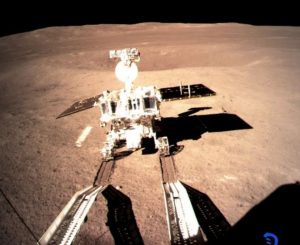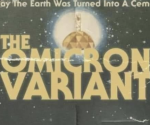A Cheng’e in the moon means a Hou Yi on earth
The Chinese have landed a craft on the far side of the moon. There is a picture where a rover has rolled down a pair of rails onto the lunar surface, and trundled over caterpillar tracks to a spot a few feet away from the lander. Of particular interest is the way that the rover has left well-defined imprints in the soil: in fact it looks like a tractor has passed through thick mud. Of course, moon soil should be devoid of moisture, and anyone who has walked on a beach on a hot day will probably understand what this entails for sand that hasn’t been wetted by the sea. In dry areas of a sandy beach above the tide line foot prints collapse, while in damp sand which is wetted by the surf, feet leave distinct and crisp impressions.
 The image from the Chang’e 4 lander (for that is its name) also adheres to that rule of moon landscape whereby one feels that the horizon is so close that one could lob a cricket ball over it. Fortunately, this impression can be excused by the apparent location of the landing site: inside an impact crater, so perhaps we are supposed to assume that the horizon is formed by the walls of this geological feature. That would be very convenient – except this particular crater is one and a half thousand miles in diameter (and 13km deep?). Apparently, then, the Chang’e 4 landed close enough to one of this crater’s edges to lob a cricket ball over it. Convenient. Incidentally, the image from the Chang’e 4 lander also demonstrates that while the technology exists to land a probe on the far side of the moon, it is still impossible to capture the stars in the sky from the surface.
The image from the Chang’e 4 lander (for that is its name) also adheres to that rule of moon landscape whereby one feels that the horizon is so close that one could lob a cricket ball over it. Fortunately, this impression can be excused by the apparent location of the landing site: inside an impact crater, so perhaps we are supposed to assume that the horizon is formed by the walls of this geological feature. That would be very convenient – except this particular crater is one and a half thousand miles in diameter (and 13km deep?). Apparently, then, the Chang’e 4 landed close enough to one of this crater’s edges to lob a cricket ball over it. Convenient. Incidentally, the image from the Chang’e 4 lander also demonstrates that while the technology exists to land a probe on the far side of the moon, it is still impossible to capture the stars in the sky from the surface.
By now everyone knows about the grosse luge propaganda technique (but do they know that the Nazis got the idea by observing others?; as Goebbels wrote: “The English follow the principle that when one lies, one should lie big, and stick to it.”ǂ)
The bigger the lie, the more likely it will be believed, and a variation of this principle applies in this case: the more preposterous the lie, the more it draws deeper those who are invested in the fiction. From the BBC:
The lander also carried a container with six live species from Earth – cotton, rapeseed, potato, fruit fly, yeast and arabidopsis (a flowering plant) – to try to form a mini biosphere.
The arabidopsis plant may produce the first flower on the Moon, Chinese state media say.
If one is concerned as to how plants on the Cheng’e lander have not been turned into straws by the unfettered sun, or from whence they will derive that which they need from the air (and for how long), then just assume that the Chang’e 4 is carrying an unlimited supply of cooling agent (a la Apollo 11 – see the FBEL article linked to below) and carbon dioxide. What next? Tim Peake taking his helmet off on an International Space Station space walk, and insisting that everything is perfectly safe? [Or “breathing is overrated?”: some would say that in those circumstances, an astronaut would not be safe from a drowning in a water tank].
The Chinese mission to the far side of the moon is one that, on the face of it, has been avoided thus far in the history of “space exploration” for a specific technical reason. Communication with earth is impossible because any craft landing on the far side is facing away into the vast expanses; there is no way to establish a direct radio link with earth. To overcome the problem, the Chinese have utilised a phenomenon that was theorised in 1969 ahead of the Apollo “moon landing”, but hadn’t been realised until now†. According to Wikipedia, Lagrangian points
are the points near two large bodies in orbit where a smaller object will maintain its position relative to the large orbiting bodies. At other locations, a small object would go into its own orbit around one of the large bodies, but at the Lagrangian points the gravitational forces of the two large bodies, the centripetal force of orbital motion, and (for certain points) the Coriolis acceleration all match up in a way that cause the small object to maintain a stable or nearly stable position relative to the large bodies.
The important application for “space exploration” is how artificial satellites can supposedly be made to keep orbits around these Lagrangian points. This might well boggle the mind of those who thought that an orbit was essentially a managed fall into a physical body in space. Indeed, a previous FBEL article (Be not surprised: Trump pledges continuation of “war-system alternative” space scam) looked into the importance of knowing where the earth-moon L1 (“neutral”) point was for alleged lunar travel.
While the L1 point in a system is intuitive in terms of imagining a situation where balance can be achieved, the other four are less so. The L2 point is beyond the smaller body of the pair in the system, and is of our particular interest because this is where the Chinese communications relay satellite, Queqiao, is “parked” in a so-called “halo orbit” beyond the moon (the reader should research this concept, and the other three Lagrangian points at his own leisure). While it is said that natural objects have taken up orbits around Lagrangian points, an artificial satellite (contradictorily) must use “station-keeping” to stay where it is intended. In other words, the craft must use thruster burns to maintain the orbit. Wikipedia states:
For spacecraft in a halo orbit around a Lagrangian point station-keeping is even more fundamental, as such an orbit is unstable; without an active control with thruster burns the smallest deviation in position/velocity would result in the spacecraft leaving the orbit completely.
The impression that one gets about Lagrangian points is that they might at least be a kind of space-equivalent of whirlpools located at the points where strong tides meet, but – and given the fact that they are dependent in their existence, and the mode and location of it, on the constant progress of two bodies (and the relationship between them) – one might suspect that they are actually quite impractical. Assume the Queqiao has an unlimited supply of fuel to perform thruster burns, perhaps? Undoubtedly, there is room to be sceptical, and one perspective to be had is this: another dubious piece of space maths has been verified by tall tales.
Moreover, the reality of the Queqiao, in the view of some critics, falls at the fundamental stumbling block of “free expansion” – or the apparently experimentally proven fact whereby gas released into a vacuum performs no work, and as such cannot “push back” against an object to propel it in the opposite direction. In short, rocketry doesn’t work in space.
It is perhaps not surprising that the BBC reports Chinese caginess in respect of their mission; by the impression to be had of it, it might be fair to say that as far as anyone outside of the operation is concerned, and as far as the data available to them goes, the Chang’e 4 appeared on the moon’s surface without getting there (from the article linked to above):
Commentators have focused on the secrecy surrounding this launch and landing. Details of the Chang’e 4 landing attempt were sketchy before the official announcement it had been a success.
The careful news management echoes the way the Soviet Union handled its space missions in the middle half of the 20th Century.
Of course, the Soviet Union didn’t have the miraculous success rate of the Americans (see the FBEL article linked to above); failure, and its prospect, is a rather good reason for secrecy. The Chinese, on the other hand, seem to be emulating the Americans in their experience. Given that space exploration is modern day Tower of Babel building [more here], fanfares and showbiz are not to be omitted when it comes to presentation. Secrecy defeats the object. The BBC did appear to rationalise “the lack of coverage on state television” as “caution by the Chinese authorities” about a risk of failure, and yet the situation marked a departure from previous well-publicized Chang’e missions. The reason for the mystery is the very fact that the Chinese Government is engaged in constructing its own moon-chasing monuments for stating a Cosmically-endorsed right to rule, and awe-striking those over whom it rules.
And when one looks at the mythology behind the naming convention of the Chinese moon missions, it becomes absolutely clear that the modern space race boils down to one Masonic faction trying to better the other in government-by-hoax.
Chang’e was the wife of an archer who shot down nine suns to leave just one in the sky. There had been ten, each one a son of the Emperor of Heaven, who transformed themselves one day to take to the sky, and burn the earth so that nothing could live. Hou Yi, the archer, was ordered to frighten them off with threats, but he decided to punish them for the destruction they had caused. He shot down the golden crow that each sun contained – the bird was the means by which each sun could travel across the sky [and then, as far as the author can make out, these orbs probably became lesser lights – the five other planets and the brighter stars, perhaps]. The Emperor of Heaven was not pleased that Hou Yi had overstepped his authority, and banished him and Chang’e so that they were deprived of their immortality. However, Hou Yi got hold of an elixir of life, of which there was enough for two to share and each become immortal. Consuming the full dose would also allow the taker to ascend to heaven as a god. While Hou Yi was recovering from his journey to retrieve the elixir, Chang’e could not control a temptation to drink it in its entirety. Once again becoming immortal, she ascended to the moon to live; having been previously banished from Heaven, she was not allowed to reside there.
Obviously, Chang’e is an Isis figure, and Hou Yi, being associated with the sun, is an Osiris one. Being rendered mortal, Hou Yi will eventually die after a human lifetime, while Chang’e will live on eternally (note, Osiris dies, and becomes integral to the human relationship with death, but Isis lives on after him to ensure his legacy). Beyond these simple comparisons, being forlornly estranged from his wife in the moon, his yearning for her (taking the form of annual worship) resembles the defiance of God a la Nimrod, another mortal, who wanted to reach the heavens by dint of his upstart tower. In some tellings of that story, Nimrod shoots an arrow into the sky, presumably in order to kill God in an ultimate act of defiance. In this respects, he is like Hou Yi, who kills not one but nine gods. While Nimrod is portrayed in Genesis as arrogant, and deserving of any punishment, in the Chinese version Hou Yi appears to be unreasonably afflicted. His crime was to adopt the viewpoint of mortals, who have suffered at the hands of the gods (Nimrod also wants to evade another catastrophe like the flood), and pays the gods back on their behalf. The Emperor of Heaven doesn’t like this, of course, because humanity should not have the power to put gods in their place. Hou Yi, therefore, is made human so that he can no longer be a champion for mankind. And so Hou Yi is Nimrod without the pro-God bias of the Genesis author – although we should not let any sympathy for Hou Yi cloud an understanding of what the Nimrod character represents in real life terms: a tyrant over men who would prove his rule by demonstrating that he cannot in fact be denied by man or god. In fact, there is no god in Luciferianism (which is what we are really talking about‡) to deny a tyrant, there are only decent men (who don’t believe the lying). Hou Yi has the arrogance of Nimrod, because his humanity is not enough, and to become a god on earth, he is willing to sacrifice those aspects of it that make him happiest. Ultimately, a Cheng’e in the moon means a Hou Yi amongst men on earth.
Further reading:
Apollo 11’s Magic Window: Faking the Earth – link
ǂ We should suspect that ultimately it is a Masonic technique germinated by the same thinking that gave the world “the end justify the means”.
† There are a number of craft said to be at the sun-earth L1 and L2 points, but the Chinese satellite is the only one that has ever been put in “orbit” around the earth-moon L2 point.
‡ In the film, The Man with the Golden Gun, during the first duel in Scaramanga’s maze (built on Chinese territory, incidentally), the gun made from gold is held in the beak of a crow. This gun, therefore, is equated to a sun of the Chang’e legend. Reinforcing this connection is the moment when Scaramanga calls the laser weapon powered by the sun a “golden gun”. This reminds that at the heart of the Cheng’e legend is an alchemical purge of the earth – a theme also at the centre of HG Well’s War of the Worlds, which is discussed in the article linked to here: Hairspray, wire and harnesses; NASA’s role in the NWO.



















Sending a robot to the moon what an amazing achievement and only 60 years after Soviet Union’s Luna 2 mission, on 13 September 1959.
As we celebrate this year 50 years since the historic manned moon landing of Apollo 11 on 20 July 1969
They hope to return for a manned mission sometime between 2030 to 2060
I hope the have more luck than when I visited the Kennedy Space Centre Lunar Theatre as NASA celebrated its 50th year in 2013
The Theatrical moon landing broke down and the theatre was evacuated.